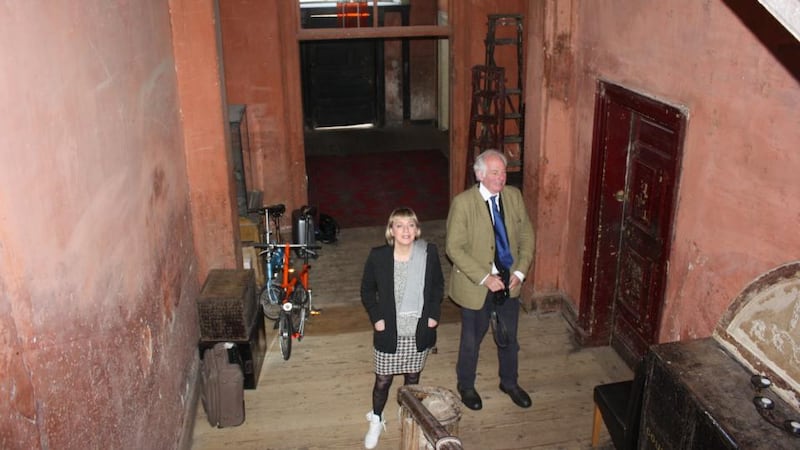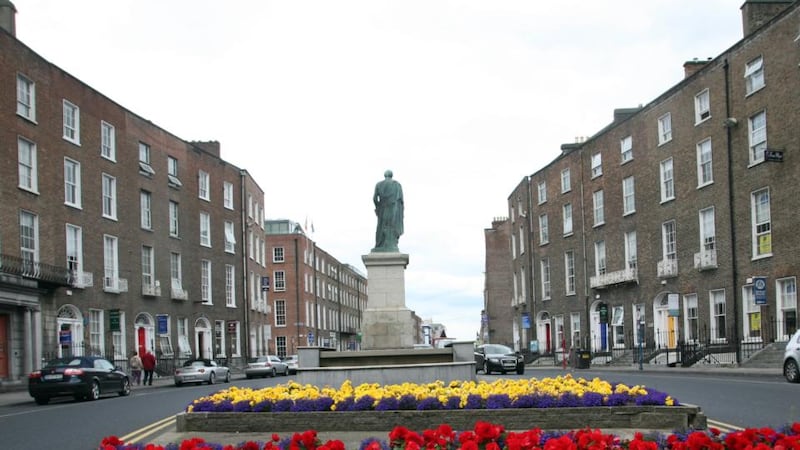Dan Cruickshank and Ian Lumley are leaning over a Georgian railing in the Sunday morning sun looking at, what to many would seem, a random concrete box tucked beside the basement of a house on Dublin's Henrietta Street. The architectural historian and the member of An Taisce eagerly discuss this early example of a water tank, comparing materials used to hold liquid in Dublin and London.
Because, while Georgian architecture in those two cities, and across Europe, speaks the same language – that of classicism – it has vernacular idiosyncrasies, Cruickshank says as we later lean tentatively over the low sill of a vast sash window. He notes, on the houses opposite, that the over-window brick detail is simpler than that in England, while, he says, Irish interiors tend to have more elaborate plasterwork.
The BBC TV presenter is staying with Lumley (and his pet snake) en route to Limerick – described by Lumley as the "western-most Renaissance city in Europe" – to revisit its Georgian heart, known as Newtown Pery. It was established in the late 18th century by Edmund Pery, First Viscount Pery, on land he owned in the former medieval quarter. Its demise is the reason why Cruickshank is here, invited by Elizabeth Hatz, a Swedish native who teaches at the school of architecture in Limerick (see panel).


But again, on his visit, Cruickshank is amazed at the details that have survived on the Limerick buildings – including examples of ironwork that have disappeared in other countries.
Cruickshank, the author of books on Georgian architecture, was just 25 when he bought a Georgian house in London’s Spitalfields, threatened with demolition. The area was known for its fruit market and weaving industry before that, but nobody wanted to live there in the 1970s. Now it is super-trendy and littered with literati.
And yet by that tender age, Cruickshank had been interested in Georgian architecture for some years following an epiphany in his teens. He was in Bloomsbury, London, where Georgian buildings (whose facades share the simplicity of Limerick Georgians, he says) were threatened with demolition. He snuck into one and was captivated by its long, dark hall: a “vista of panelled walls (and a tramp asleep in the front room). It was a magical moment of insight. I thought, this is so beautiful how can it be demolished?”
The demolishers won the day with a tale of a dangerous chimney stack. “It was heartbreaking,” says Cruickshank. “I thought, never again.”
He helped set up the Spitalfields Trust to save such buildings which, he says, are beautiful by default.
Works of art
"They were products of speculation by builders and merchants. Yet through a weird magic alchemy, base ambitions were turned into noble gold. They created works of art. I became fascinated by the way that something so unambitious intellectually could end up being so inspirational, poetic and beautiful," says Cruickshank, lamenting that current products of ruthless speculation in the property market often do not achieve the same result.
The gorgeous Georgians were partly a result of the beautiful materials people built with then and also, says Cruickshank, a need to attract buyers with fashionable elements. “There are details in Georgian buildings which are clearly superfluous to the function but they were put there for the marketplace.” Door cases, for instance, got changed from time to time as did interiors, to follow fashions of the day.
“It was intriguing how builders had enough ability to apply the language of classicism in a vernacular way.”
A huge contributor to their learning was the advent of printing, making texts, such as those describing Palladio’s work, more accessible, and pattern books began to be produced.
Few architects did the grand tour to experience actual examples of classicism: Wren went to Paris once, Hawksmoor never left England, although John Soane, says Cruickshank, did a small tour, picking up lucrative clients en route.
And, because of local fashions and vernacular interpretations of the classical language, each European country came up with its own version of the style.
For that reason, Cruickshank believes Georgian architecture in Ireland should not be seen as a shadow of the English style. "People say, this is bloody English architecture imposed on this country, but there is also another way of reading it. It has a direct cultural connection to mainland Europe in the 18th century. Dublin and Limerick are part of a European urban culture. They are internationally important. A lot of European classicists came directly to Ireland: they are nothing to do with England."
He points to Castletown House's Italian designer Alessandro Galilei from Venice and the German-French designer Richard Cassels (who Anglicised his name to Castle), who designed a number of buildings including Leinster House.
Limerick was planned by Italian engineer Davis Ducart: "He came straight here, he did not come via England."
And while English architects came to Dublin, they adopted an Irish style, says Cruickshank. William Chambers and James Gandon "did Irishified designs. The designs have a dignity, distinction and beauty which are of the land and all good architecture, in a way, has that.
"The famous detail in Ireland, which you don't get in England, is the great French-inspired full-height bow window lighting an oval room. It happens in the White House, designed also by an Irish architect."
Limerick, too, shares an architectural language with the US with whom it had strong trading links. There are similarities between the buildings of Limerick (whose terraces have more uniform facades than Dublin’s) and parts of New York, for instance on MacDougal Street and Mercer Street, such as door cases and Ionic capitals, and this is something Cruickshank would like to research further.
The way to save buildings is to find a use for them, says Cruickshank, “It is futile if they have no use.”
And if someone wanted to take on a Georgian building, what's his best advice? "Take it slowly," he says. "Love it for what it is. Such buildings carry evidence of lives lived. If you rip everything out and make it new, you've destroyed the point of it."
City of Culture: Limerick's Georgian heart on the world map
When professor of architecture Elizabeth Hatz began teaching at the University of Limerick seven years ago, the Swedish native was struck by the beauty of the city's Georgian grid (Newton Pery) but noted, with dismay, its further demise since.
“It is one of the most undervalued cities I have ever come across. It’s of national interest – even European interest – and we need to have an action plan.”
The fact that Limerick is City of Culture next year offers good motivation for further action, says Hatz, who is heartened by t he fact the council has bought some Georgian buildings to put them to use.
Last weekend Hatz gathered interested parties including Deputy Mayor Marie Byrne, Jan O'Sullivan, Minister of State with responsibility for Housing and Planning, Dan Cruickshank, and Ian Lumley and James Nix from An Taisce.
O’Sullivan said they would look back in 10 years’ time and see that as the evening on which they decided to make a real change in the city.



















